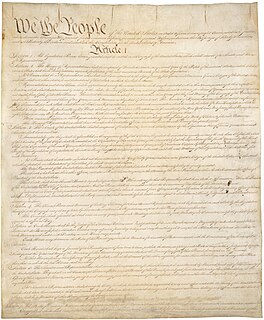
The Constitution of the United States is the supreme law of the United States of America. This founding document, originally comprising seven articles, delineates the national frame of government. Its first three articles embody the doctrine of the separation of powers, whereby the federal government is divided into three branches: the legislative, consisting of the bicameral Congress ; the executive, consisting of the president and subordinate officers ; and the judicial, consisting of the Supreme Court and other federal courts. Article IV, Article V and Article VI embody concepts of federalism, describing the rights and responsibilities of state governments, the states in relationship to the federal government, and the shared process of constitutional amendment. Article VII establishes the procedure subsequently used by the 13 States to ratify it. It is regarded as the oldest written and codified national constitution in force.

Article Five of the United States Constitution describes the process whereby the Constitution, the nation's frame of government, may be altered. Under Article V, the process to alter the Constitution consists of proposing an amendment or amendments, and subsequent ratification.

A constitutional convention is a gathering for the purpose of writing a new constitution or revising an existing constitution. Members of a constitutional convention are often, though not necessarily or entirely, elected by popular vote. However, a wholly popularly-elected constitutional convention can also be referred to as a constituent assembly.

The Convention for the Suppression of the Traffic in Persons and of the Exploitation of the Prostitution of Others was approved by the United Nations General Assembly on 2 December 1949 and entered into force on 25 July 1951. The preamble states:
"Whereas prostitution and the accompanying evil of the traffic in persons for the purpose of prostitution are incompatible with the dignity and worth of the human person and endanger the welfare of the individual, the family and the community"

The Vienna Convention on the Law of Treaties (VCLT) is an international agreement regulating treaties between states. Known as the "treaty on treaties", it establishes comprehensive rules, procedures, and guidelines for how treaties are defined, drafted, amended, interpreted, and generally operated. An international treaty is a written agreement between international law subjects reflecting their consent to the creation, alteration, or termination of their rights and obligations. The VCLT is considered a codification of customary international law and state practice concerning treaties.

The American Convention on Human Rights, also known as the Pact of San José, is an international human rights instrument. It was adopted by many countries in the Western Hemisphere in San José, Costa Rica, on 22 November 1969. It came into force after the eleventh instrument of ratification was deposited on 18 July 1978.
Ratification is a principal's approval of an act of its agent that lacked the authority to bind the principal legally. Ratification defines the international act in which a state indicates its consent to be bound to a treaty if the parties intended to show their consent by such an act. In the case of bilateral treaties, ratification is usually accomplished by exchanging the requisite instruments, and in the case of multilateral treaties, the usual procedure is for the depositary to collect the ratifications of all states, keeping all parties informed of the situation.

A convention to propose amendments to the United States Constitution, also called an Article V Convention or amendatory convention, applied for by two-thirds of the state legislatures, is one of two processes authorized by Article Five of the United States Constitution whereby the United States Constitution may be altered. Amendments may also be proposed by Congress with a two-thirds vote in both the House of Representatives and the Senate.
Unemployment Convention, 1919 is an International Labour Organization Convention.
The Convention concerning the Rights of Association and Combination of Agricultural Workers is an International Labour Organization Convention adopted in 1921. The convention secures the rights of "association and combination" of agricultural workers to the same extent as those rights are extended to industrial workers. As of July 2015, 123 states have ratified the convention.
White Lead (Painting) Convention, 1921 is an International Labour Organization Convention established in 1921 to advance the prohibition of using white lead in paint.
Medical Examination of Young Persons (Sea) Convention, 1921 is an International Labour Organization Convention.
Sickness Insurance (Agriculture) Convention, 1927 is an International Labour Organization Convention.
Minimum Wage-Fixing Machinery Convention, 1928 is an International Labour Organization Convention.
Employment Injury Benefits Convention, 1964 is an International Labour Organization Convention.
Holidays with Pay (Agriculture) Convention, 1952 is an International Labour Organization Convention.

The Cape Town Convention on International Interests in Mobile Equipment, or Cape Town Treaty is an international treaty intended to standardize transactions involving movable property. The treaty creates international standards for registration of contracts of sale, security interests (liens), leases and conditional sales contracts, and various legal remedies for default in financing agreements, including repossession and the effect of particular states' bankruptcy laws.

The Virginia Ratifying Convention was a convention of 168 delegates from Virginia who met in 1788 to ratify or reject the United States Constitution, which had been drafted at the Philadelphia Convention the previous year.